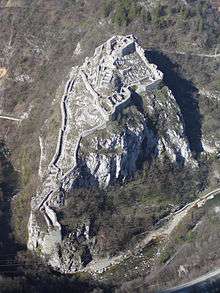Stari Grad, Užice
| Old town Stari Grad | |
|---|---|
|
Užice Serbia | |
|
An aerial view of Stari Grad | |
 Old town Stari Grad | |
| Coordinates | 43°51′07″N 19°49′44″E / 43.852°N 19.829°E |
| Type | Fortification |
| Site history | |
| Built | 12th-13th century |
| Materials | Stone |
Stari Grad (Serbian Cyrillic: Стари град; meaning old town) is the remains of a fortress near the city of Užice, in central Serbia. It is an example of typical medieval Serbian architecture. Historians believe it was built between the 12th and 13th centuries to control movement along nearby roads, and the town of Užice. It is positioned on a large steep cliff, and surrounded on three sides by the river Đetinja. Today it consists of several ruined buildings, including the citadel and many of its surrounding walls. Stari Grad was declared Protected Monuments of Culture in 1983, and it is protected by Republic of Serbia.[1]
History

Serbian župan from the 14th century, Nikola Altomanović (Vojinović) ruled vast areas from Rudnik, over Polimlje, Podrinje, east Herzegovina with Trebinje, until Konavle and Dračevica, neighboring the Republic of Dubrovnik. He was defeated and blinded in Užice (fortress Užice) in 1373 by a coalition of his neighbors Knez Lazar and Bosnian king Tvrtko I Kotromanić, supported by the king Ludovik I of Hungary.[2]
During next almost five hundred, the fortress was settled by Turkish army. From that period there is a great number of legends. According to the legend which describes how the Đetinja River got its name, the Ottoman Turks in the times when they ruled these lands, once punished the local Užican people by taking their children and brutally throwing them into the river. Thus the river was named Đetinja rijeka, which in Užican dialect means the children's river.
The town was destroyed in January 1863, along with six others according to the peace treaty, signed by Mihailo Obrenović, when the Ottomans left the fortresses.
From 2000 to 2002, there was a summer theatre stage on the top.
See also
References
- ↑ Monuments of Culture in Serbia: УЖИЧКИ ГРАД (SANU) (Serbian) (English)
- ↑ Fine (The Late Medieval Balkans – 1994), p. 385.
Bibliography
- Fine, John Van Antwerp (1994). The Late Medieval Balkans: A Critical Survey from the Late Twelfth Century to the Ottoman Conquest. Michigan: The University of Michigan Press. ISBN 0472100793.
External links
| Wikimedia Commons has media related to Užice Fortress. |
- (Serbian) Uzice.net - Stari Grad

